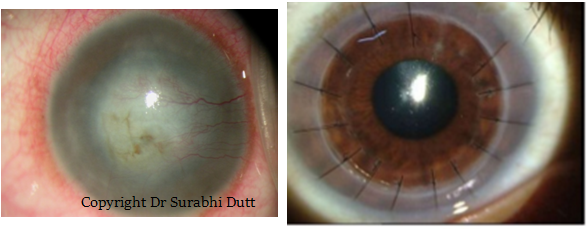Corneal Transplant in Delhi
Cornea is a part of the anterior segment of the eye, this clear tissue covers the front portion of each eye. Any light which enters the eye, first passes through it, then the pupil to the lens. Aanya Eye Clinic offers the best cornea transplant treatment in Delhi. The medical terminology of cornea transplant is KERATOPLASTY. In this surgical procedure, as the name suggests the eye surgeon replaces a portion of the damaged cornea after removing it; with a new cornea portion from a donor.
Why one needs cornea transplant?
– A patient may require cornea transplant, if the cornea is scarred from any eye infection or disease.
– If the cornea is damaged from trauma
– For patients with an eye degenerative disease called Keratoconus which makes it thin and distorts the shape of the cornea.
– Hereditary conditions like Lattice dystrophy, Fuchs’ dystrophy.
Types of Cornea Transplant
There are two types of cornea transplants
1. Full Cornea Transplant
2. Lamellar Cornea Transplant
This cornea tissue has five layers and in case all the five layers are replaced by a healthy cornea, it is called Full penetrating cornea transplant. Alternatively, if only selective layers are replaced, it is called Lamellar Cornea Transplant.
Full Cornea Transplant Procedure
1. Firstly, the patient’s eye is numbed with the use of local anaesthetic drops. In some cases for unstable patients, general anaesthesia may be used.
2. With the help of a special instrument called the “trepine”, the eye surgeon removes the damaged section of the cornea. This instrument functions like a cookie cutter.
3. Similarly from the donor eye, required cornea is cut with similar dimensions.
4. This healthy cornea is then with the help of ultra-thin stitches is stitched to the recipient eye with the help of a microscope.
Lamellar Cornea Transplant Procedure
1. In this transplant only selective layers of the cornea, which are damaged when at times the disease has not reached all layers are replaced. Sometimes the deepest layer is replaced in the procedure called – posterior lamellar cornea transplant. Most commonly done lamellar transplants are :
i. DMEK Descemet’s Membrane Endothelial Keratoplasty
ii. DSAEK Descemet’s Stripping Automated Endothelial Keratoplasty
Deep Anterior Lamellar Keratoplasty (DALK): This is a relatively new surgical methodology for selective removal of diseased or damaged corneal layers. In a traditional full cornea transplant procedure full thickness cornea is replaced but most of the times the innermost –endothelium layer is not diseased but healthy. In full cornea transplant this is also replaced and has chances of rejection making the post operative steriods medication necessary. In DALK, this innermost layer is retained as only the anterior layers are replaced. This prevents the long term usage of steroid medications. Thus patient is safe guarded from long term steroid usage risks of developing glaucoma, cataract or secondary infections from full corneal transplant.
Post Operative Recovery
Because of the “immunologically privileged” quality of the cornea, matching of the donor and the recipients is not required.
– Steroid drops are advised to the patient, which provide the eye with immunity against external infection and prevent rejection of the graft.
– The complications are minimum if the transplant is done for outer layers as compared to deeper layers full penetrating cornea transplant.
– Though there may be some problems like scarring, bleeding – very rare, fluid leakage from transplant, retinal detachment and vision problems.
Cornea as a tissue has slow healing tendency and the patient is required to wear a protective shield on the operated eye for a few days. Also the use of eye drops postoperatively may extend to over a period of few months. The stitches are removed much later during a clinic visit.
The vision recovery is a slow process as the cornea heals. Any irritation or new discomfort in related to vision should be shared with the operating surgeon. This will help the surgeon arrest any rejection in time which can easily be altered with the use of medication. Also this rejection may take place after several years post operatively, in such cases also the cornea can be saved with timely intervention.

